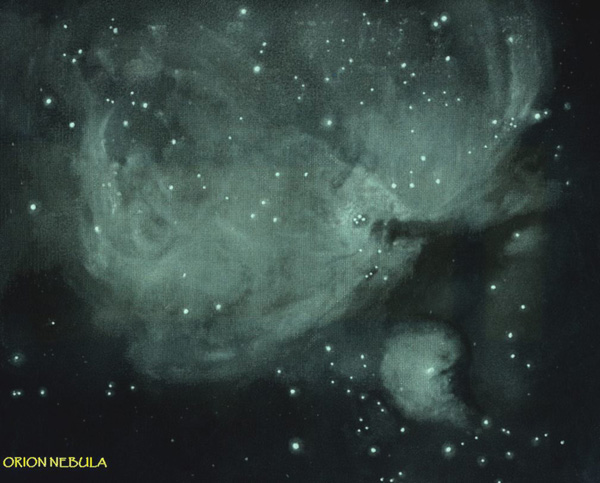The Orion nebula may be one of the most challenging objects in the sky to observe.
The amount of subtle detail it displays is astonishing and it is perhaps one of the
most difficult nebula to sketch.
Edward Holden’s monograph on the central area of M42 (Central Parts of the Nebula of
Orion, Washington Astronomical Observations for 1878, Appendix I) inspired me to
attempt to follow the footsteps of great visual observers of the the past — the
Herschels, Lassell, Rosse, Bond, etc.– and try to capture the wealth of details
seen in my 18″ reflector. I might add that my sketch is a composite drawing made
with apertures ranging from 70mm to a 20″ reflector. A separate drawing was made on
each evening of observing and combined into a single rendering. The Dearborn
Observatory star maps (claimed to go down to the 18th magnitude) were used to insure
the proper “placing” of the details noted with the various telescopes. The
(unfinished) drawing is still a work in progress after two years of observing.
Magnifications on my 18″ reflector ranged from ~60X (40 mm Pentax) to ~460X (5mm
Radian). The lowest power used: 12X with my Pronto 70mm refractor!
I settled on using a graphite pencil after experimenting with charcoal and soft
lead pencils. Nothing fancy here — just graphite on regular (economy) typing
paper from Office Depot. The drawing was color-inverted using my HP scanner and
tinted with the Paint program.
An extended observing session revealed details I hadn’t noticed before. The
remarkable D’Arrest “comets” were visible only when the transparency was good. The
prominent dark “globule” W1 was seen so well through a 24″ reflector one evening
that my first impression was that there was a bit of dirt on the field lens of my
eyepiece!
I hope that in another two years I can finish the drawing.
Dave Riddle


Dear Dave,
This is an incredible piece of work, it is simply stunning!If you hadn’t said I would never had known it was unfinished. The Great nebula is one of those objects that you feel you must capture but being able to do it justice is another matter, you have certainly managed that Sir!
Dale
My God, this is nuts!!
It’s the damn best drawing I’ve ever seen of M 42, it’s one one of those sketches, when you see it, you wish you had done it yourself!
Absolutely awe-inspiring work!
I don’t even want to imagine, what it will look like after another two years of observing, when it’s finished!
Sebastian
Dave,
A marathon drawing beyond written description.
Frank
I have no words…incredible!
what realism…
Great! thanks
Leonor
Holy cow! This sketch blew me away. What detail. Such subtleties handled so deftly. I’ve always meant to try M42 for a sketch, but two years? *gulp* Such dedication.
Dave,
A truly remarkable study of skill and patience. It must give you a deep insight into your subject. It illuminates for me a comment by the English landscape painter John Constable – ‘Painting is a science and should be pursued as an enquiry into the laws of nature.’
J.E.Thomas
Thanks, folks! All the flattering remarks are keenly appreciated.
I failed to mention that I did not use any of the Lumicon filters to make the sketch. I was trying to capture the natural look of M42, so the filters stayed in my eyepiece case.
As to the unfinished business, the stars are not scaled properly and some the bright patches of the nebula are much too prominent.
My one regret is that I can’t seem to master the colors in the nebula. The bold red/yellow streak in the “bright bar” and the pink-gray tint to west of the trapezium have proven to next to impossible to draw. At this point, I don’t want to spend a lot of time mastering Photoshop!
Thank you
Dave